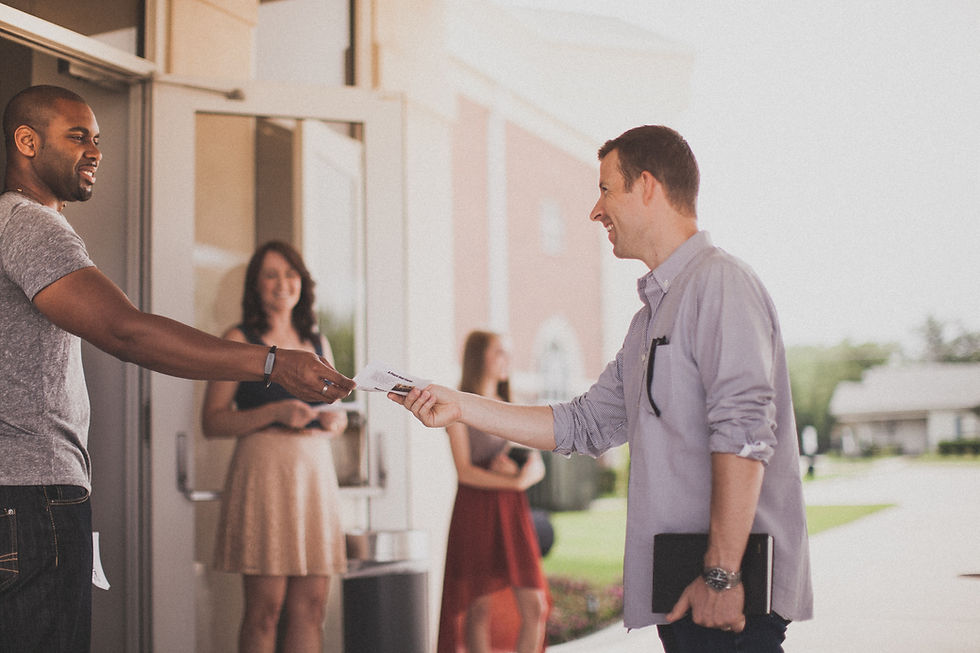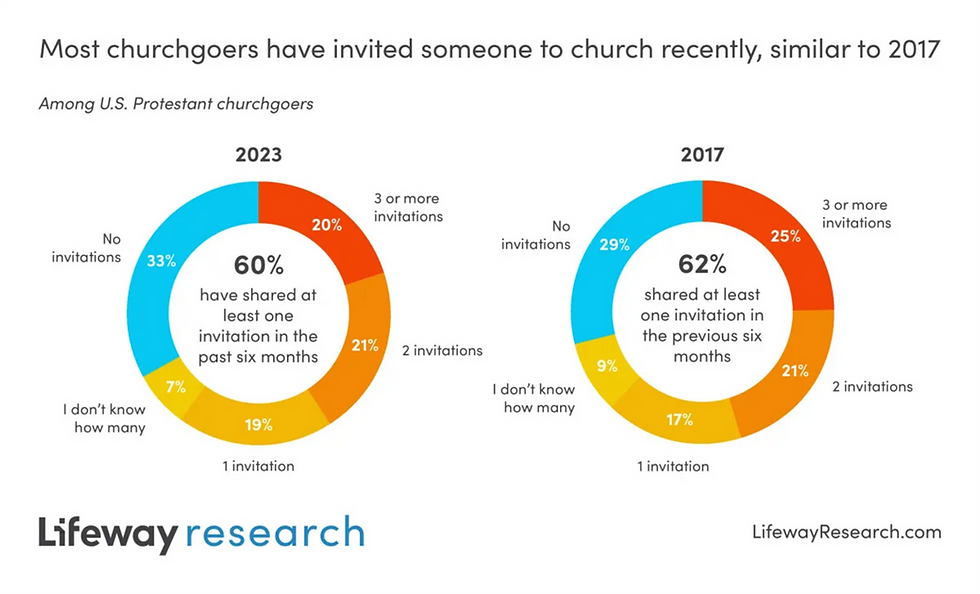The Power of Personal Invitation: What the Research Says About Church Growth
- Invite Welcome Connect

- Aug 6
- 4 min read
Updated: Aug 26
When was the last time you invited someone to church?

It might seem simple—or even outdated—but recent research from across the Christian landscape confirms something we’ve long known instinctively: a personal invitation is still the most effective way to bring new people into the life of a church.
Whether you’re a lay leader, a vestry member, or a clergy person discerning how to grow your congregation, this is good news. You don’t need a viral video, a new building, or a huge advertising budget. You just need courage, intention, and a culture of invitation.
People Come to Church Because Someone Invited Them
In study after study, this truth emerges: most people who start attending a church do so because someone they know invited them.
According to research conducted multiple times over the past decade, more than half say a personal connection was one of the top reasons they chose their current church. In fact, it ranked higher than worship style, denominational affiliation, or even the church’s website.
The Numbers Back It Up
Let’s look at the data:
A Lifeway Research survey—widely cited in church growth circles—found that 96% of unchurched adults say they would be somewhat or very likely to attend church if personally invited. (Source via Wikipedia)
A recent Barna Group report, Making Space for Church Visitors (2024), reveals that pastors overwhelmingly believe their congregations are welcoming to new people—and that personal relationships remain the primary way guests first encounter a church.
The 2020 Faith Communities Today report found that 72% of growing churches encourage members to invite others—compared to just 43% of declining churches.
The conclusion is clear: churches that grow are churches that invite.
It’s Not Just for Evangelicals
Sometimes progressive or mainline churches shy away from words like evangelism or invitation, worried that it sounds pushy or performative. But in Episcopal, Lutheran, Methodist, and other mainline settings, the data still holds true.
Ministries like Invite Welcome Connect consistently find that participants come because someone invited them personally. Invitation is a form of radical hospitality. It’s relational. It’s rooted in love.

Who Is Inviting Others to Church?
According to a 2024 article in Christianity Today, 60% of U.S. Protestant churchgoers say they’ve invited at least one person to church in the past six months. This breaks down as follows:
19% made one invitation
21% invited two people
20% extended three or more invitations
Meanwhile, 33% of churchgoers did not invite anyone during that period, and 7% were unsure how many invitations they had made.
Patterns by Attendance Frequency
Churchgoers who attend more frequently are more likely to extend invitations. Among those who attend four or more times per month, 27% had invited three or more people. By contrast, only 11% of those who attend one to three times per month had done the same.
Demographic Trends: Age, Race, and Belief
Age:
Ages 50–64: about 32% made no invitations
Ages 65 and older: about 46% made no invitations
Ages 35–49: the most active group, with nearly 29% extending three or more invitations
Race:
African American churchgoers reported high invitation activity: 28% made two invitations, and 25% made three or more
White attendees were more likely than other groups to report zero invitations (36%), compared to African Americans (26%) and Hispanics (18%)
Differences by Denomination and Belief
By Church Tradition:
Baptists: 27% invited three or more people
Restorationist Movement: 21%
Presbyterian/Reformed: only 9%
Lutherans had the highest percentage of people reporting no invitations (52%)
By Belief:
Evangelical Protestants: 24% invited three or more
Non-evangelicals: 15%
Barriers to Invitation
Among those who didn’t invite others to church, reasons varied:
27% said they don’t know someone to invite
26% had experienced declined invitations
13% felt uncomfortable extending an invitation
7% said it wasn’t their responsibility
4% were too busy on Sundays
19% didn’t have a specific reason
5% cited another unspecified reason
Summary
The data suggest that personal invitation is still widely practiced among Protestant churchgoers, especially among frequent attenders, younger adults, and members of certain racial and denominational groups. However, barriers such as social networks, discomfort, and rejection still inhibit broader outreach. For congregations seeking growth and renewal, fostering a culture of invitation—and equipping members to overcome these barriers—could be a key strategy.
What This Means for Your Church
Here are a few practical steps your congregation can take:
Equip your members to invite others confidently
Normalize invitation in sermons, newsletters, and small groups
Celebrate stories of people who came because someone reached out
Use tools like Invite Welcome Connect to create a culture of relational evangelism
And most importantly: start with one invitation. It might change someone’s life.
A Final Word
“Evangelism is just one beggar telling another beggar where to find bread.”— D.T. Niles
At its heart, invitation is not about numbers or success metrics. It’s about love. It's about offering community, meaning, and hope to people who are already longing for it.
Let’s not keep that to ourselves.
Want to build a culture of invitation in your parish?
Contact Invite Welcome Connect to learn about workshops, coaching, and free resources that can support your congregation’s growth.






Comments